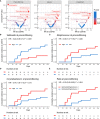Dental Biofilm Microbiota Dysbiosis Is Associated With the Risk of Acute Graft- Versus-Host Disease After Allogeneic Hematopoietic Stem Cell Transplantation
- PMID: 34220852
- PMCID: PMC8250416
- DOI: 10.3389/fimmu.2021.692225
Dental Biofilm Microbiota Dysbiosis Is Associated With the Risk of Acute Graft- Versus-Host Disease After Allogeneic Hematopoietic Stem Cell Transplantation
Abstract
Acute graft-versus-host disease (aGVHD) is one of the major causes of death after allogeneic hematopoietic stem cell transplantation (allo-HSCT). Recently, aGVHD onset was linked to intestinal microbiota (IM) dysbiosis. However, other bacterial-rich gastrointestinal sites, such as the mouth, which hosts several distinctive microbiotas, may also impact the risk of GVHD. The dental biofilm microbiota (DBM) is highly diverse and, like the IM, interacts with host cells and modulates immune homeostasis. We characterized changes in the DBM of patients during allo-HSCT and evaluated whether the DBM could be associated with the risk of aGVHD. DBM dysbiosis during allo-HSCT was marked by a gradual loss of bacterial diversity and changes in DBM genera composition, with commensal genera reductions and potentially pathogenic bacteria overgrowths. High Streptococcus and high Corynebacterium relative abundance at preconditioning were associated with a higher risk of aGVHD (67% vs. 33%; HR = 2.89, P = 0.04 and 73% vs. 37%; HR = 2.74, P = 0.04, respectively), while high Veillonella relative abundance was associated with a lower risk of aGVHD (27% vs. 73%; HR = 0.24, P < 0.01). Enterococcus faecalis bloom during allo-HSCT was observed in 17% of allo-HSCT recipients and was associated with a higher risk of aGVHD (100% vs. 40%; HR = 4.07, P < 0.001) and severe aGVHD (60% vs. 12%; HR = 6.82, P = 0.01). To the best of our knowledge, this is the first study demonstrating that DBM dysbiosis is associated with the aGVHD risk after allo-HSCT.
Keywords: acute GVHD; allogeneic HSCT; bone marrow transplant; microbiome dysbiosis; oral microbiota; supragingival plaque.
Copyright © 2021 Heidrich, Bruno, Knebel, de Molla, Miranda-Silva, Asprino, Tucunduva, Rocha, Novis, Arrais-Rodrigues, Fregnani and Camargo.
Conflict of interest statement
The authors declare that the research was conducted in the absence of any commercial or financial relationships that could be construed as a potential conflict of interest.
Figures




Similar articles
-
Alteration of Gut Microbiota Composition and Diversity in Acute and/or Chronic Graft-versus-Host Disease Following Hematopoietic Stem Cell Transplantation: A Prospective Cohort Study.Int J Mol Sci. 2024 May 26;25(11):5789. doi: 10.3390/ijms25115789. Int J Mol Sci. 2024. PMID: 38891979 Free PMC article.
-
Intestinal Microbiota at Engraftment Influence Acute Graft-Versus-Host Disease via the Treg/Th17 Balance in Allo-HSCT Recipients.Front Immunol. 2018 Apr 24;9:669. doi: 10.3389/fimmu.2018.00669. eCollection 2018. Front Immunol. 2018. PMID: 29740427 Free PMC article.
-
The Potential Roles of Mucosa-Associated Invariant T Cells in the Pathogenesis of Gut Graft-Versus-Host Disease After Hematopoietic Stem Cell Transplantation.Front Immunol. 2021 Sep 3;12:720354. doi: 10.3389/fimmu.2021.720354. eCollection 2021. Front Immunol. 2021. PMID: 34539656 Free PMC article.
-
Microbiome: An Emerging New Frontier in Graft-Versus-Host Disease.Dig Dis Sci. 2019 Mar;64(3):669-677. doi: 10.1007/s10620-018-5369-9. Epub 2018 Dec 7. Dig Dis Sci. 2019. PMID: 30523482 Review.
-
Fecal microbiota transplantation in the treatment of intestinal steroid-resistant graft-versus-host disease: two case reports and a review of the literature.J Int Med Res. 2020 Jun;48(6):300060520925693. doi: 10.1177/0300060520925693. J Int Med Res. 2020. PMID: 32527171 Free PMC article. Review.
Cited by
-
The Impact of Enterococcus spp. in the Immunocompromised Host: A Comprehensive Review.Pathogens. 2024 May 15;13(5):409. doi: 10.3390/pathogens13050409. Pathogens. 2024. PMID: 38787261 Free PMC article. Review.
-
Characteristics of lower respiratory tract microbiota in the patients with post-hematopoietic stem cell transplantation pneumonia.Front Cell Infect Microbiol. 2022 Sep 13;12:943317. doi: 10.3389/fcimb.2022.943317. eCollection 2022. Front Cell Infect Microbiol. 2022. PMID: 36176576 Free PMC article.
-
Long-Term Analysis of Resilience of the Oral Microbiome in Allogeneic Stem Cell Transplant Recipients.Microorganisms. 2022 Mar 29;10(4):734. doi: 10.3390/microorganisms10040734. Microorganisms. 2022. PMID: 35456787 Free PMC article.
-
Oral microbiome alterations after cancer treatment: a scoping review and analysis.Med Oncol. 2025 Aug 19;42(10):432. doi: 10.1007/s12032-025-02998-6. Med Oncol. 2025. PMID: 40828300 Free PMC article. Review.
-
Characterization of Oral Microbiota Following Chemotherapy in Patients With Hematopoietic Malignancies.Integr Cancer Ther. 2023 Jan-Dec;22:15347354231159309. doi: 10.1177/15347354231159309. Integr Cancer Ther. 2023. PMID: 36922730 Free PMC article.
References
-
- Greinix HT, Eikema D-J, Koster L, Penack O, Yakoub-Agha I, Montoto S, et al. . Incidence of Acute Graft-Versus-Host Disease and Survival After Allogeneic Hematopoietic Cell Transplantation Over Time: A Study From the Transplant Complications and Chronic Malignancies Working Party of the EBMT. Blood (2018) 132(Supplement 1):2120–0. 10.1182/blood-2018-99-111764 - DOI
-
- Golob JL, Pergam SA, Srinivasan S, Fiedler TL, Liu C, Garcia K, et al. . Stool Microbiota at Neutrophil Recovery Is Predictive for Severe Acute Graft vs Host Disease After Hematopoietic Cell Transplantation. Clin Infect Dis Off Publ Infect Dis Soc Am (2017) 65(12):1984–91. 10.1093/cid/cix699 - DOI - PMC - PubMed
Publication types
MeSH terms
LinkOut - more resources
Full Text Sources

